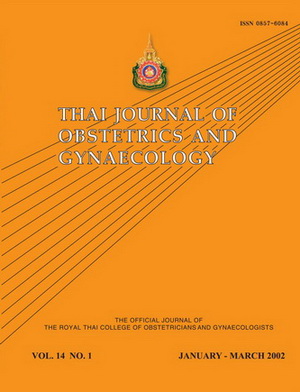Mammographic Findings in Women attending Menopause Clinic at King Chulalongkorn Memerial Hospital
Main Article Content
Abstract
Objectives To determine the prevalence of high risk mammographic pattern, according to Wolfe’
s classification and to assess the association of these findings with some clinical and hormonal
characteristics of the women who had been using HRT.
Design A retrospective descriptive study.
Setting Menopause Clinic, Chulalongkorn Hospital.
Material and methods High resolution mammography was performed in 165 women. Wolfe’s
mammographic parenchymal classification was used with the knowledge that women with dense
patterns have a higher risk of developing breast cancer. Four types of mammographic
parenchymal density were classified. The N1and P1 were categorized in “low risk
mammographic pattern” where as the P2 and DY were categorized in “high risk mammographic
pattern”. We ran the regression of mammographic risk pattern against age, body mass index,
age at menarche, menopausal status, type of menopause, parity and the use of HRT.
Results Of the 165 women in this study, 21 (12.7%) were premenopausal and 144 (87.3%)
were postmenopausal. The mean age of these women was 52.34 ± 5.66 years old. BMI of
these woman range from 18 to 34 and the mean BMI was 23.89 ± 3.00 kg/m 2. One hundred
and thirty six (82.4%) women were married and 29 (17.6%) women were unmarried. Of the
144 postmenopausal women, 104 (72.2%) women were natural menopause, 37 (25.7%) women
were surgical menopause and 3 (2.1%) women were premature menopause. The prevalence
of the high risk and the low risk mammographic pattern in this study was 73.9 percent and 26.1
percent, respectively. Only the age of the patients and the use of HRT are significantly
associated with high risk mammographic parenchymal pattern.
Conclusion We found high prevalence of high risk mammographic pattern in pre- and
postmenopausal women. Age and the use of HRT are found to be associated with high risk
mammographic pattern.
s classification and to assess the association of these findings with some clinical and hormonal
characteristics of the women who had been using HRT.
Design A retrospective descriptive study.
Setting Menopause Clinic, Chulalongkorn Hospital.
Material and methods High resolution mammography was performed in 165 women. Wolfe’s
mammographic parenchymal classification was used with the knowledge that women with dense
patterns have a higher risk of developing breast cancer. Four types of mammographic
parenchymal density were classified. The N1and P1 were categorized in “low risk
mammographic pattern” where as the P2 and DY were categorized in “high risk mammographic
pattern”. We ran the regression of mammographic risk pattern against age, body mass index,
age at menarche, menopausal status, type of menopause, parity and the use of HRT.
Results Of the 165 women in this study, 21 (12.7%) were premenopausal and 144 (87.3%)
were postmenopausal. The mean age of these women was 52.34 ± 5.66 years old. BMI of
these woman range from 18 to 34 and the mean BMI was 23.89 ± 3.00 kg/m 2. One hundred
and thirty six (82.4%) women were married and 29 (17.6%) women were unmarried. Of the
144 postmenopausal women, 104 (72.2%) women were natural menopause, 37 (25.7%) women
were surgical menopause and 3 (2.1%) women were premature menopause. The prevalence
of the high risk and the low risk mammographic pattern in this study was 73.9 percent and 26.1
percent, respectively. Only the age of the patients and the use of HRT are significantly
associated with high risk mammographic parenchymal pattern.
Conclusion We found high prevalence of high risk mammographic pattern in pre- and
postmenopausal women. Age and the use of HRT are found to be associated with high risk
mammographic pattern.
Article Details
How to Cite
(1)
Rungruxsirivorn, T.; Punyakhamlerd, K.; Vacharakupt, L.; Taechakraichana, N.; Limpaphayom, K. K. Mammographic Findings in Women attending Menopause Clinic at King Chulalongkorn Memerial Hospital. Thai J Obstet Gynaecol 2017, 14, 63-72.
Section
Original Article


